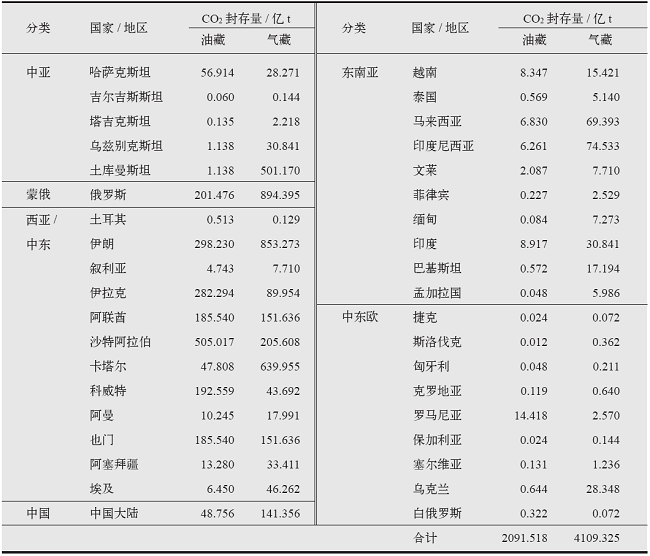| [1] |
傅京燕, 司秀梅. “一带一路”沿线国家碳排放驱动因素、减排贡献与潜力[J]. 热带地理, 2017,37(1):1-9.
doi: 10.13284/j.cnki.rddl.002917
URL
|
|
Fu J Y, Si X M. Driving factors of carbon emission of the countries along “the Belt and Road”, their potential and contribution to the emission reduction[J]. Tropical Geography, 2017,37(1):1-9 (in Chinese)
|
| [2] |
British Petroleum. BP statistical review of world energy 2018 [R/OL]. 2018 [2019-05-16]. https://www.bp.com/content/dam/bp/business-sites/en/global/corporate/pdfs/energy-economics/statistical-review/bp-stats-review-2018-full-report.pdf
|
| [3] |
IPCC. Climate change 2014: synthesis report. Summary for policy makers [M/OL]. New York: Cambridge University Press, 2014 [2019-05-16]. https://www.ipcc.ch/site/assets/uploads/2018/02/AR5_SYR_FINAL_SPM.pdf
|
| [4] |
Minchener A J. Gasification based CCS challenges and opportunities for China[J]. Fuel, 2014,116(1):904-909
doi: 10.1016/j.fuel.2013.02.046
URL
|
| [5] |
He M, Luis S, Rita S. et al Risk assessment of CO2 injection processes and storage in carboniferous formations: a review[J]. Journal of Rock Mechanics and Geotechnical Engineering, 2011,3(1):39-56
doi: 10.3724/SP.J.1235.2011.00039
URL
|
| [6] |
Sun L L, Dou H E, Li Z P, et al. Assessment of CO2 storage potential and Carbon Capture, Utilization and Storage prospect in China[J]. Journal of the energy institute, 2018,91:970-977
doi: 10.1016/j.joei.2017.08.002
URL
|
| [7] |
Liu T, Xu G, Liu X, et al. Impacts of CCS and other CO2 mitigation options on China’s electric power industry[C]. IEEE: Power & Energy Engineering Conference, 2010,104:28-31
|
| [8] |
中国21世纪议程管理中心, 科学技术部. 中国碳捕集、利用与封存技术发展路线图[M]. 北京: 科学出版社, 2019.
|
|
The Administrative Center for China’s Agenda 21, Ministry of Science and Technology. Roadmap for Carbon Capture, Utilization and Storage technology development in China [M]. Beijing: Science Press, 2019 (in Chinese)
|
| [9] |
沈平平, 廖新维, 刘庆杰. 二氧化碳在油藏中埋存量计算方法[J]. 石油勘探与开发, 2009,36(2):216-220.
doi: 10.1016/S1876-3804(09)60121-X
URL
|
|
Shen P P, Liao X W, Liu Q J. Methodology for estimation of CO2 storage capacity in reservoirs[J]. Petroleum Exploration and Development, 2009,36(2):216-220 (in Chinese)
|
| [10] |
赵晓亮, 廖新维, 王万福, 等. 二氧化碳埋存潜力评价模型与关键参数的确定[J]. 特种油气藏, 2013,20(6):72-74.
|
|
Zhao X L, Liao X W, Wang W F, et al. Evaluative model of CO2 geological sequestration and determination of key parameters[J]. Special Oil & Gas Reservoirs, 2013,20(6):72-74 (in Chinese)
|
| [11] |
Zhang L, Li X, Ren B, et al. CO2 storage potential and trapping mechanisms in the H-59 block of Jilin oilfield China[J]. International Journal of Greenhouse Gas Control, 2016,49:267-280
doi: 10.1016/j.ijggc.2016.03.013
URL
|
| [12] |
孙扬, 杜志敏, 孙雷, 等. CO2的埋存与提高天然气采收率的相行为[J]. 天然气工业, 2012,32(5):39-42.
doi: 10.3787/j.issn.1000-0976.2012.05.010
URL
|
|
Sun Y, Du Z M, Sun L, et al. Phase behavior of CO2 sequestration and the enhanced natural gas recovery[J]. Natural Gas Industry, 2012,32(5):39-42 (in Chinese)
|
| [13] |
Goodman A, Hakala A, Bromhal G, et al. U.S. DOE methodology for the development of geologic storage potential for carbon dioxide at the national and regional scale[J]. International Journal of Greenhouse Gas Control, 2011,5(4):952-965
doi: 10.1016/j.ijggc.2011.03.010
URL
|
| [14] |
CSLF. Estimation of CO2 storage capacity in geological media [R/OL]. 2007 [2019-05-16]. https://www.cslforum.org/cslf/sites/default/files/documents/PhaseIIIReportStorageCapacityEstimationTaskForce0408.pdf
|
| [15] |
Warwick P D, Verma M K, Attanasi E D, et al. A database and probabilistic assessment methodology for carbon dioxide: enhanced oil recovery and associated carbon dioxide retention in the United States[J]. Energy Procedia, 2017,114:7055-7059
doi: 10.1016/j.egypro.2017.03.1847
URL
|
| [16] |
谢尚贤, 韩培慧. 大庆油田萨南东部过渡带注CO2驱油先导性矿场试验研究[J]. 油气地质与采收率, 1997 (3):13-19.
|
|
Xie S X, Han P H. A pilot test and research on oil displacement by injecting CO2 in eastern Sanan of Daqing oilfield[J]. Petroleum Geology and Recovery Efficiency, 1997 (3):13-19 (in Chinese)
|
| [17] |
史云清, 贾英, 潘伟义, 等. 致密低渗透气藏注CO2提高采收率潜力评价[J]. 天然气工业, 2017,37(3):62-69.
|
|
Shi Y Q, Jia Y, Pan W Y, et al. Potential evaluation on CO2-EGR in tight and low-permeability reservoirs[J]. Natural Gas Industry, 2017,37(3):62-69 (in Chinese)
|
| [18] |
陈欢庆, 胡永乐, 田昌炳. CO2驱油与埋存研究进展[J]. 油田化学, 2012,29(1):118-123.
|
|
Chen H Q, Hu Y L, Tian C B. Advances in CO2 displacing oil and CO2 sequestrated researches[J]. Oilfield Chemistry, 2012,29(1):118-123 (in Chinese)
|
| [19] |
罗二辉, 胡永乐, 李保柱, 等. 中国油气田注CO2提高采收率实践[J]. 特种油气藏, 2013,20(2):1-7.
|
|
Luo E H, Hu Y L, Li B Z, et al. Practices of CO2 EOR in China[J]. Special Oil & Gas Reservoirs, 2013,20(2):1-7 (in Chinese)
|
| [20] |
Sun L L, Hao X N, Dou H E, et al. Co-optimization of oil recovery and CO2 storage for cyclic CO2 flooding in ultralow permeability reservoirs[J]. Oil & Gas Science and Technology, 2018,73(42):1-7
|
| [21] |
Duan Z. An improved model calculating CO2 solubility in pure water and aqueous NaCl solutions from 273 to 533 K and from 0 to 2000 bar[J]. Chemical Geology, 2003,193(3):257-271
doi: 10.1016/S0009-2541(02)00263-2
URL
|
| [22] |
Global CCS Institute. The global status of CCS: 2015. Volume 2: projects, policy and markets [R/OL]. 2015 [2019-05-16]. https://www.globalccsinstitute.com/resources/publications-reports-research/the-global-status-of-ccs-2015-volume-2-projects-policy-and-markets/
|
| [23] |
International Energy Agency. IEA energy technology perspectives 2015 [R/OL]. 2015 [2019-05-16]. https://www.iea.org/reports/energy-technology-perspectives-2015
|
 ), GE Quan-Sheng
), GE Quan-Sheng




